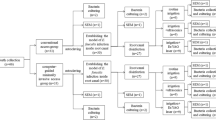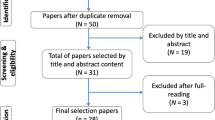Abstract
Purpose
Due to the limited effectiveness of irrigation to reduce the bacterial load inside root canals, the efficacy of activated irrigation techniques was evaluated.
Methods
Sixty endodontically prepared single-rooted human teeth were sterilized, infected with Enterococcus faecalis, and divided into six groups: (A) endodontic treatment positive control, (B) irrigation with EDTA 17%, (C) Er:YAG laser activated irrigation with tip 1 mm from working length, (D) Er:YAG laser to the coronal third, (E) ultrasonic irrigation applied 1 mm from working length, (F) US irrigation to the coronal third.
Results
The positive control group had significantly more bacteria than all other groups. EDTA irrigation had low efficiency. US irrigation 1 mm from the working length was significantly more effective than controls. Laser treatment to the coronal third was the most efficient.
Conclusions
Laser activated irrigation caused the greatest bacterial reductions.



Similar content being viewed by others
References
Kakehashi S, Stanley HR, Fitzgerald RJ (1965) The effects of surgical exposures of dental pulps in germ-free and conventional laboratory rats. Oral Surg Oral Med Oral Pathol 20:340–349
Sjogren U, Figdor D, Persson S, Sundqvist G (1997) Influence of infection at the time of root filling on the outcome of endodontic treatment of teeth with apical periodontitis. Int Endod J 30:297–306
Peters LB, Wesselink PR (2002) Periapical healing of endodontically treated teeth in one and two visits obturated in the presence or absence of detectable microorganisms. Int Endod J 35:660–667
Weiger R, Rosendahl R, Lost C (2000) Influence of calcium hydroxide intracanal dressings on the prognosis of teeth with endodontically induced periapical lesions. Int Endod J 33:219–226
Peters OA, Schonenberger K, Laib A (2001) Effects of four Ni-Ti preparation techniques on root canal geometry assessed by micro computed tomography. Int Endod J 34:221–230
Senna RA, Spohr AR, Gastmann AH, Pappen FG, Lima RKP, Morgental RD (2018) The effect of EDTA on the antibacterial activity of sodium hypochlorite. Gen Dent 66:74–78
Molander A, Reit C, Dahlen G (1999) The antimicrobial effect of calcium hydroxide in root canals pretreated with 5% iodine potassium iodide. Endod Dent Traumatol 15:205–209
Bystrom A, Sundqvist G (1983) Bacteriologic evaluation of the effect of 0.5 percent sodium hypochlorite in endodontic therapy. Oral Surg Oral Med Oral Pathol 55:307–312
Torabinejad M, Handysides R, Khademi AA, Bakland LK (2002) Clinical implications of the smear layer in endodontics: a review. Oral Surg Oral Med Oral Pathol Oral Radiol Endod 94:658–666
Brannstrom M (1984) Smear layer: pathological and treatment considerations. Oper Dent Suppl 3:35–42
Haapasalo M, Orstavik D (1987) In vitro infection and disinfection of dentinal tubules. J Dent Res 66:1375–1379
Pashley DH (1984) Smear layer: physiological considerations. Oper Dent Suppl 3:13–29
Paster BJ, Olsen I, Aas JA, Dewhirst FE (2006) The breadth of bacterial diversity in the human periodontal pocket and other oral sites. Periodontol 2000 42:80–87
Love RM (2001) Enterococcus faecalis - a mechanism of its role in endodontic failure. Int Endod J 34:399–405
Nielsen BA, Baumgartner JC (2007) Comparison of the EndoVac system to needle irrigation of root canals. J Endod 33:611–615
de Gregorio C, Estevez R, Cisneros R, Paranjpe A, Cohenca N (2010) Efficacy of different irrigation and activation systems on the penetration of sodium hypochlorite into simulated lateral canals and up to working length: an in vitro study. J Endod 36:1216–1221
Pedulla E, Genovese C, Campagna E, Tempera G, Rapisarda E (2012) Decontamination efficacy of photon-initiated photoacoustic streaming (PIPS) of irrigants using low-energy laser settings: an ex vivo study. Int Endod J 45:865–870
Adcock JM, Sidow SJ, Looney SW Liu Y, McNally K, Lindsey K, Tay FR (2011) Histologic evaluation of canal and isthmus debridement efficacies of two different irrigant delivery techniques in a closed system. J Endod 37:544–548
Jiang LM, Verhaagen B, Versluis M, Langedijk J, Wesselink P, van der Sluis LW (2011) The influence of the ultrasonic intensity on the cleaning efficacy of passive ultrasonic irrigation. J Endod 37:688–692
Deleu E, Meire MA, De Moor RJ (2015) Efficacy of laser-based irrigant activation methods in removing debris from simulated root canal irregularities. Lasers Med Sci 30:831–835
Green J, Weiss A, Stern A (2011) Lasers and radiofrequency devices in dentistry. Dent Clin N Am 55:585–597 ix–x
Sahar-Helft S, Stabholtz A, Moshonov J, Gutkin V, Redenski I, Steinberg D (2013) Effect of Er:YAG laser-activated irrigation solution on enterococcus faecalis biofilm in an ex-vivo root canal model. Photomed Laser Surg 31:334–341
de Groot SD, Verhaagen B, Versluis M, Wu MK, Wesselink PR, van der Sluis LW (2009) Laser-activated irrigation within root canals: cleaning efficacy and flow visualization. Int Endod J 42:1077–1083
Blanken J, De Moor RJ, Meire M, Verdaasdonk R (2009) Laser induced explosive vapor and cavitation resulting in effective irrigation of the root canal. Part 1: a visualization study. Lasers Surg Med 41:514–519
De Moor RJ, Blanken J, Meire M, Verdaasdonk R (2009) Laser induced explosive vapor and cavitation resulting in effective irrigation of the root canal. Part 2: evaluation of the efficacy. Lasers Surg Med 41:520–523
George R, Meyers IA, Walsh LJ (2008) Laser activation of endodontic irrigants with improved conical laser fiber tips for removing smear layer in the apical third of the root canal. J Endod 34:1524–1527
George R, Walsh LJ (2008) Apical extrusion of root canal irrigants when using Er:YAG and Er,Cr:YSGG lasers with optical fibers: an in vitro dye study. J Endod 34:706–708
Nakamura VC, Cai S, Candeiro GT, Ferrari PH, Caldeira CL (2013) Gavini. Int Endod 46:217–224
van der Waal SV, Oonk CA, Nieman SH, Wesselink PR, de Soet JJ, Crielaard W (2015) Additional disinfection with a modified salt solution in a root canal model. J Dent 43:1280–1284
Siqueira JF Jr (2001) Strategies to treat infected root canals. J Calif Dent Assoc 29:825–837
Wu MK, van der Sluis LWM, Wesselink PR (2003) The capability of two hand instrumentation techniques to remove the inner layer of dentine in oval canals. Int Endod J 36:218–224
Johnson WT, Noblett WC (2009) Cleaning and shaping in: endodontics: principles and practice, 4th edn. Saunders, Philadelphia, PA
Goswami M, Chhabra N, Kumar G, Verma M, Chhabra A (2014) Sodium hypochlorite dental accidents. Paediatr Int Child Health 34:66–69
Mohammadi Z, Shalavi S, Giardino L, Palazzi F, Asgary S (2015) Impact of ultrasonic activation on the effectiveness of sodium hypochlorite: a review. Iran Endod J 10(4):216–220
Sanchez F, Espana Tost AJ, Morenza JL (1997) ArF excimer laser irradiation of human dentin. Lasers Surg Med 21:474–479
Kuah HG, Lui JN, Tseng PS, Chen NN (2009) The effect of EDTA with and without ultrasonics on removal of the smear layer. J Endod 35:393–396
Sahar-Helft S, Sarp AS, Stabholtz A, Gutkin V, Redenski I, Steinberg D (2015) Comparison of positive-pressure, passive ultrasonic, and laser-activated irrigations on smear-layer removal from the root canal surface. Photomed Laser Surg 33:129–135
Meire MA, Havelaerts S, De Moor RJ (2016) Influence of lasing parameters on the cleaning efficacy of laser-activated irrigation with pulsed erbium lasers. Lasers Med Sci 31:653–658
Lee SJ, Wu MK, Wesselink PR (2004) The effectiveness of syringe irrigation and ultrasonics to remove debris fromsimulated irregularities within prepared root canal walls. Int Endod J 37:672–678
van Leeuwen TG, van de Veen MJ, Verdaasdonk RM, Borst C (1991) Non contact tissue ablation by holmium:YSGG laser pulses in blood. Lasers Surg Med 11:26–34
Lorencetti KT, Silva-Sousa YT, Nascimento GE, Messias DC, Colucci V, Rached-Junior FA (2014) Influence of apical enlargement in cleaning of curved canals using negative pressure system. Braz Dent J 25:430–434
Funding
There is no funding source.
Author information
Authors and Affiliations
Corresponding author
Ethics declarations
The study was approved by the Hadassah Hospital Ethics Committee, approval no. 0118-14-HMO.
Conflict of interest
The authors declare that they have no conflict of interest.
Ethical approval
This article does not contain any studies with human participants or animals performed by any of the authors.
Informed consent
Informed consent was obtained from all individual participants included in the study. [Optional].
Rights and permissions
About this article
Cite this article
Sahar-Helft, S., Sarp, A.S.K., Gulsoy, M. et al. Efficacy of ultrasonic and Er:YAG laser activated EDTA irrigation in removing bacteria from ex vivo root canal system. Laser Dent Sci 2, 265–269 (2018). https://doi.org/10.1007/s41547-018-0046-z
Received:
Accepted:
Published:
Issue Date:
DOI: https://doi.org/10.1007/s41547-018-0046-z




